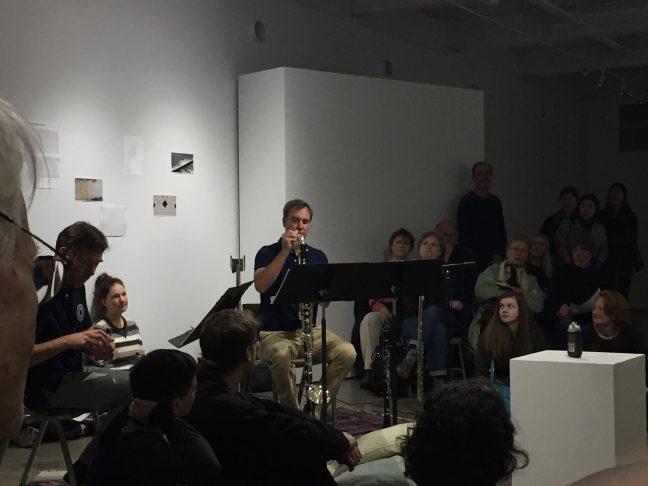The scarcity and inequality of water is not an issue frequently talked about in America, as the vast majority of people in our country have no problems accessing clean water. For the most part, water is taken for granted where we live.
While regions in Palestine are only receiving 100 liters of water per day, hundreds, if not thousands of people in Los Angeles are lounging in their backyards, not even using their swimming pools.
“Displaced Horizons,” a multimedia project funded by The Holtz Center for Science and Technology Studies, challenges the notion that water should be taken for granted and explores issues of water inequality around the world through a variety of artistic mediums.
The third and most recent event hosted by “Displaced Horizons” emphasized the use of music to explore the meaning of water and featured a concert-long performance of one piece.

William Lundquist/The Badger Herald
The seventh-floor gallery of the George L. Mosse Humanities building supplied chairs and pillows for everyone to sit on, but the event was more well-attended than the organizers had planned. Many stood around the performers while the musicians were in a circle facing one another. Different pieces of artwork reflecting an aspect of water hung on the walls accompanied by infographics conveying water scarcity statistics.
On either side of the room, videos were projected on the walls, played on a loop. The videos displayed drone shots of both flowing waterfalls and dry landscapes affected by drought or water scarcity.
The musicians were situated in the middle of the room, with the audience dispersed around them, sitting on pillows. This created an intimate but comfortable setting which made the performance feel informal and allowed the audience to relax. Many closed their eyes while listening to the music, accentuating a clearly intentional decision to make the event seem less like a concert and more like a collaborative project exploring the social and political issue of water scarcity.
The music that took up the majority of the event was bizarre and hardly sounded like music. The score featured an upright bass, saxophone, full percussion set, clarinet and flute. Each instrument was heavily used to create its own, unique sound, ideally representing water. Notably, each instrument’s sounds flowed into the next, and the sound never fully stopped, bringing the concept of water to life. To emphasize the flow of the music, the sound would crescendo, quickly becoming softer, and then replaced by another instrument before fading out.

William Lundquist/The Badger Herald
The music was quite dissonant and abstract throughout. Yet while each instrument was doing something radically different, there still seemed to be a cohesiveness to the performance. The music had a mysteriousness to it, and while listening, the setting felt like a jungle or somewhere deep in the wilderness, with all the foreign sounds fading in and out of earshot.
Composer Rob Lundberg spent a lot of time researching the subject matter of his music: water. He tried to experience it in many different settings to fully understand how water influences sound and gather inspiration from it. He said he would bring his bass down into the bottom of a well and play there. Lundberg spent a lot of time sitting by streams, waterfalls and dams taking notes of water patterns and sounds.
With the music he wrote for the “Displaced Horizons” event, Lundberg wanted there to be an end result to his process.
“[The goal was to] take all the ideas about water and water infrastructure and express them sonically,” Lundberg said.

William Lundquist/The Badger Herald
The most compelling aspect of the event was not the music, but the other ways in which “Displaced Horizons” contributors explored the issue of water inequality and the political systems which leave their own mark on the issue. One of the events main organizers, Alexandra Lakinde, described the work that “Displaced Horizons” has been doing.
“We have been working in multiple contexts — musical, sociological and topographical,” Lakinde said.
Her statement was reflected by the variety of ways water scarcity was presented, both through images, as well as maps and infographics.
One of the cartographers for the gallery was present at the event and wished to remain anonymous due to the political nature of their work, but provided some context for their maps displaying the water disparity in Israel. The cartographer then drew comparisons to water disparities in Palestine and Gaza.

William Lundquist/The Badger Herald
In a system of what the cartographer referred to as “water apartheid,” Israel’s government is drilling deeper wells in Palestinian villages than they do in their own, depleting the water table and creating uneven access to water. Furthermore, the Israeli military shattered a water pipeline supplying a Palestinian village with fresh drinking water and irrigation for farms. According to the cartographer, these two cases are clear illustrations of unequal access to water.
“Displaced Horizons” is undoubtedly an ambitious project, spreading awareness about water inequality through many different forms of art. It was probably one of the most unique events a student can attend on campus all year, due to the bizarre musical performance being paired with an important global issue. The event will make onlookers question how they think about water, and the alarming injustices being done to those who deserve access to clean water.


